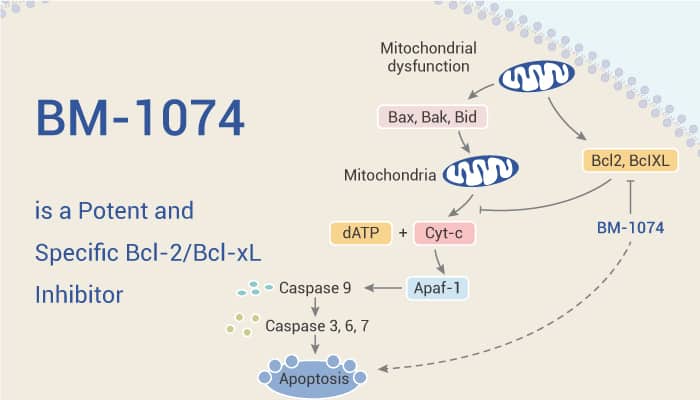Bcl-2 (B-cell lymphoma 2) and Bcl-xL (B-cell lymphoma-extra large) are members of the Bcl-2 family of proteins. BCL-2 is localized to the outer membrane of mitochondria, where it plays an important role in promoting cell survival and inhibiting the actions of pro-apoptotic proteins. As well as, Bcl-xL acts as an anti-apoptotic protein by preventing the release of mitochondrial contents such as cytochrome c, which leads to caspase activation and ultimately, programmed cell death.
Bcl-2 and Bcl-xL always is overexpression in many different types of human tumors, which make tumor cells resistant to conventional cancer therapeutic agents. Therefore, small-molecule inhibitors of Bcl-2 and Bcl-xL may have a promising therapeutic potential for the treatment of human cancer.
BM-1074 has inhibitory activity against Bcl-2 and Bcl-xL.
BM-1074 is a potent and specific Bcl-2 and Bcl-xL inhibitor with IC50 values of 1.8 nM and 6.9 nM for Bcl-2 and Bcl-xL, respectively. Besides, BM-1074 binds to Bcl-2 and Bcl-xL proteins with Ki values of < 1 nM. Moreover, BM-1074 shows antiproliferative and anti-tumor activity. Following research, BM-1074 potently inhibits cancer cell growth in the H146 small-cell lung cancer cell line and achieves an IC50 value of 1.3 nM. In addition, BM-1074 shows antiproliferative activity with IC50 values of 1, 1.4, and 2.3 nM for H1936, H187, and H1417 cells, respectively.

BM-1074 (15 mg/kg; i.v.; 5 days a week for 2 weeks) shows anti-tumor activity in the H146 xenograft tumors in SCID mice. Moreover, BM-1074 increases the expression of cleavage PARP and caspase-3 protein at both 3 and 6-hr time points in H146 tumor tissues. Furthermore, the results indicate the strong apoptosis induction in vivo. Additionally, BM-1074 decreases the tumor size and no significant weight loss (<5%) and did not show other signs of toxicity during or after the treatment.
In a word, BM-1074 is a potent and specific Bcl-2 and Bcl-xL inhibitor, possessing antiproliferative and anti-tumor activity.
Reference:
[1] Aguilar A, et al. J Med Chem. 2013 Apr 11;56(7):3048-3067.